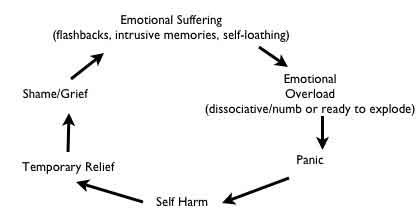Self harm is confusing. Always. Why would someone do that? But it is not unintelligible. It makes sense. At least it makes sense to the person doing the harm. This presentation takes a close look at the experience of self-harm in real time. What does self-abuse look like when it’s fresh, raw, unspeakable? It’s not easy to watch.
You will get a lot more out of my lecture below if you first watch episode three of Season One of Intervention (an A&E Network program). The episode is called “Tamela and Jerrie”. You can (a) Buy a copy from iTunes for $1.99 (search for Tamela. It is the “Tamela and Jerrie” episode) or (b) Buy the episode for $1.99 from Amazon Instant Video. (Links to an external site.) Please note: this video includes very graphic images of self harm (cutting). There is blood. It is not pretty. If you are a cutter yourself or in a relationship with someone who is engaged in self harm or just someone who for whatever reason should not be watching scenes of someone cutting themselves, you do not need to watch this video even though it is referred to multiple times in the video below. General principle: be kind to yourself.
LECTURE NOTES:
Cultural Context
- We live in a violent, “no pain, no gain” culture.
- Self-harm is often culturally acceptable (e.g. body art, medically unnecessary cosmetic surgery, violent sports, high-risk behaviors).
- Religious convictions sometimes reinforce/contribute to self harm (penance, “finishing out the sufferings of Christ”, “mortification of the flesh”, self-loathing, body hostility)
Myths About Self-Harm
- People who self-harm are just trying to get attention.
- Self-inflicted violence is just an attempt to manipulate others.
- People who self-injure are crazy.
- If the wounds aren’t “bad enough,” self-harm isn’t serious.
- Only teen-aged girls self-injure.
Common characteristics of adolescent self-harm
- Repetitive, non-suicidal injury not associated with delusions, hallucinations or mental retardation.
- Common Forms: superficial cutting, scratching, hitting, burning, hair pulling
- Typical age of onset: 13-14
- Co-occuring disorders: anxiety disorders, substance abuse, eating disorders, depression
- Complicated Issues:
- Link to sexual abuse?
- Suicide risk or anti-suicidal behavior?
- Addictive aspects of self-harm?
Common dynamics

What’s the motivation?
- Pain as evidence I exist. (I can still feel!)
- Affect modulation (distraction from unwanted affect, a preference for intelligible pain.)
- Self-punishment (This is what I deserve. Purification?)
- Expression of things that can’t be put into words (returning to the scene of the crime?)
- The visualization of unexperienced experiences (body memories?)
- Maintaining control (a pain I can control, reenactment of abuse in a way that allows me to be in a more powerful role?)
How to Be Helpful
| Hurtful Things | Helpful Things |
| Panic/Shock/Call 911/Allow their anxiety to trigger my anxiety | Stay calm. Get appropriate help to manage my own anxiety. |
| Respond/argue about ideas or attempt to control behavior(rewards or punishments). | Respond to emotional pain and make room for expression of that pain. |
| Telling them they shouldn’t do that. Telling them God doesn’t want them to do that. | Listen |
| Tell them to try harder, pray harder etc. | Tell them you care about and respect them |
| Hope for the best. Refer and disengage. | Stay engaged, encourage them to seek professional help and to find multiple safe places to talk about their issues |
Articles
- Katherine Ryan, Melissa Allen Heath, Lane Fischer and Ellie L. Young, Superficial Self-Harm: Perceptions of Young Women Who Hurt Themselves. Journal of Mental Health Counseling Volume 30/Number 3/July 2008/Pages 237–254 [Full text available online at EBSCOhost. Accession Number: 2008-09842-005]
- Jacqueline Mangnall and Eleanor Yurkovich, A Literature Review of Deliberate Self-Harm, Perspectives in Psychiatric Care, Vol 44(3), Jul 2008. pp. 175-184. [Full text available online at EBSCOhost. Accession Number: 2008-09619-005]
- E. David Klonsky and Jennifer Muehlenkamp, Self-injury: A research review for the practitioner, Journal of Clinical Psychology, Vol 63(11), Nov 2007. pp. 1045-1056. [ [Full text available online at EBSCOhost. Accession Number: 2007-16760-002]
Web Sites
- Self Multilators Anonymous
- S.A.F.E. Alternatives: a treatment program
- Lysamena Project on Self-Injury
- Cornell Research Program on Self-Injurious Behavior
Books
- Conterio, K. & Lader, W. (1998). Bodily harm: The breakthrough treatment program for self-injurers.(Hyperion)
- Favazza, A. R. (1996). Bodies under siege: Self-mutilation and body modification in culture and psychiatry (2nd ed.). (Johns Hopkins University Press)
- Miller, D. (2005)Women Who Hurt Themselves: A book of hope and understanding. (Basic Books)
- Clarke, A. (1999). Coping with self-mutilation: A helping book for teens who hurt themselves. (Hazeldon)
- Alderman, T. (1997). The scarred soul: Understanding and ending self-inflicted violence. Oakland, CA: New Harbinger.
